GS Paper I
News Excerpt:
The International Organization for Migration (IOM) launched the World Migration Report 2024, which reveals significant shifts in global migration patterns, including a record number of displaced people and a major increase in international remittances.
About the report:
- Since 2000, IOM has been producing its flagship world migration reports every two years.
- The World Migration Report 2024, is the twelfth in the World Migration Report series.
- In a world grappling with uncertainty, understanding migration dynamics is essential for informed decision-making and effective policy responses.
- The last two years saw major migration and displacement events that have caused great hardship and trauma, as well as loss of life. In addition to the conflicts in Ukraine and Gaza, millions of people have been displaced due to conflict.
- There have also been large-scale displacements triggered by climate- and weather-related disasters in many parts of the world.
- We also witnessed the intensification of migration as a political tool in democratic systems around the world with some national elections being fought on anti-immigration sentiment, especially in Europe.
Key highlights of the report:
- The report highlights that international migration remains a driver of human development and economic growth, highlighted by a more than 650 percent increase in international remittances from 2000 to 2022, rising from USD 128 billion to USD 831 billion.
- With an estimated 281 million international migrants (3.6% of the global population) worldwide, the number of displaced individuals due to conflict, violence, disaster, and other reasons has surged to the highest levels in modern-day records, reaching 117 million.
- Of that 831 billion in remittances, 647 billion were sent by migrants to low– and middle-income countries. These remittances can constitute a significant portion of those countries' GDPs, and globally, these remittances now surpass foreign direct investment in those countries.
- Intensification of ecologically negative human activity: Overconsumption and overproduction linked to unsustainable economic growth, resource depletion, and biodiversity collapse, as well as ongoing climate change (including global heating), are continuing to grip the world.
- Most migration is regular, safe, and regionally focused, directly linked to opportunities and livelihoods. Yet, misinformation and politicization have clouded public discourse.
-
Long-term data shows that international migration is not uniform across the world but is shaped by economic, geographic, demographic, and other factors resulting in distinct migration patterns, such as migration “corridors” developed over many years.
- Migration corridors represent an accumulation of migratory movements over time and provide a snapshot of how migration patterns have evolved into significant foreign-born populations in specific destination countries.
- More than 40 percent of all international migrants worldwide in 2020 (115 million) were born in Asia, nearly 20 percent primarily originating from six Asian countries, including India (the largest country of origin), China, Bangladesh, Pakistan, Philippines, and Afghanistan. Mexico was the second-largest country of origin, and the Russian Federation was third.
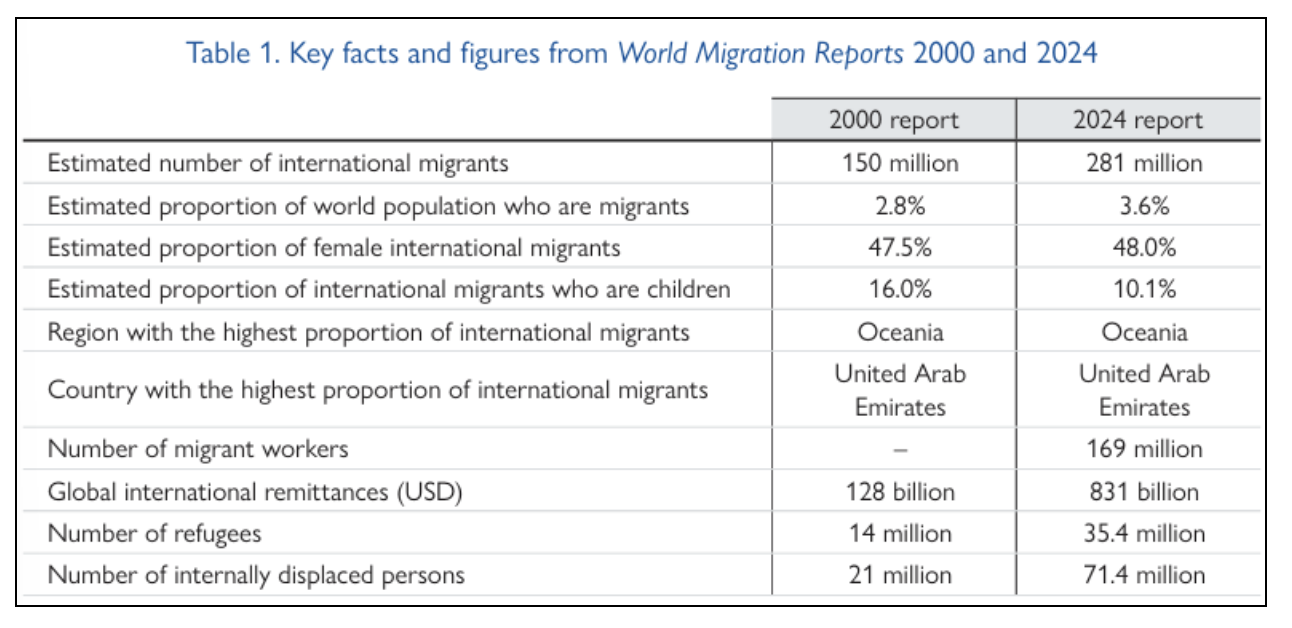
Summary of the report:
Chapter 2 provides an overview of the latest available global data and trends on international migrants (stocks) and international migration (flows).
- It also provides a discussion of particular migrant groups – namely, migrant workers, international students, refugees, asylum-seekers, and internally displaced persons – as well as of international remittances.
- With an estimated 281 million international migrants (3.6% of the global population) worldwide, the number of displaced individuals due to conflict, violence, disaster, and other reasons has surged to the highest levels in modern-day records, reaching 117 million.
- The vast majority of people continue to live in the countries where they were born —only one in 30 are migrants.
- The overwhelming majority of people migrate internationally for reasons related to work, family and study. This migration is mostly safe, orderly, and regular.
- In contrast, other people leave their homes and countries for a range of compelling and sometimes tragic reasons, such as conflict, persecution and disaster.
- Refugees: By the end of 2022, there was a total of 35.3 million refugees globally, with 29.4 million under UNHCR’s mandate, and 5.9 million refugees registered by the United Nations Relief and Works Agency for Palestine Refugees (UNRWA).
- Asylum Seekers: There were also approximately 5.4 million people seeking international protection and awaiting determination of their refugee status, referred to as asylum-seekers.
- Internally displaced persons: At an estimated 62.5 million, the total global stock of people internally displaced by conflict and violence in 65 countries and territories as of 31 December 2022 was the highest on record since IDMC began monitoring in 1998.
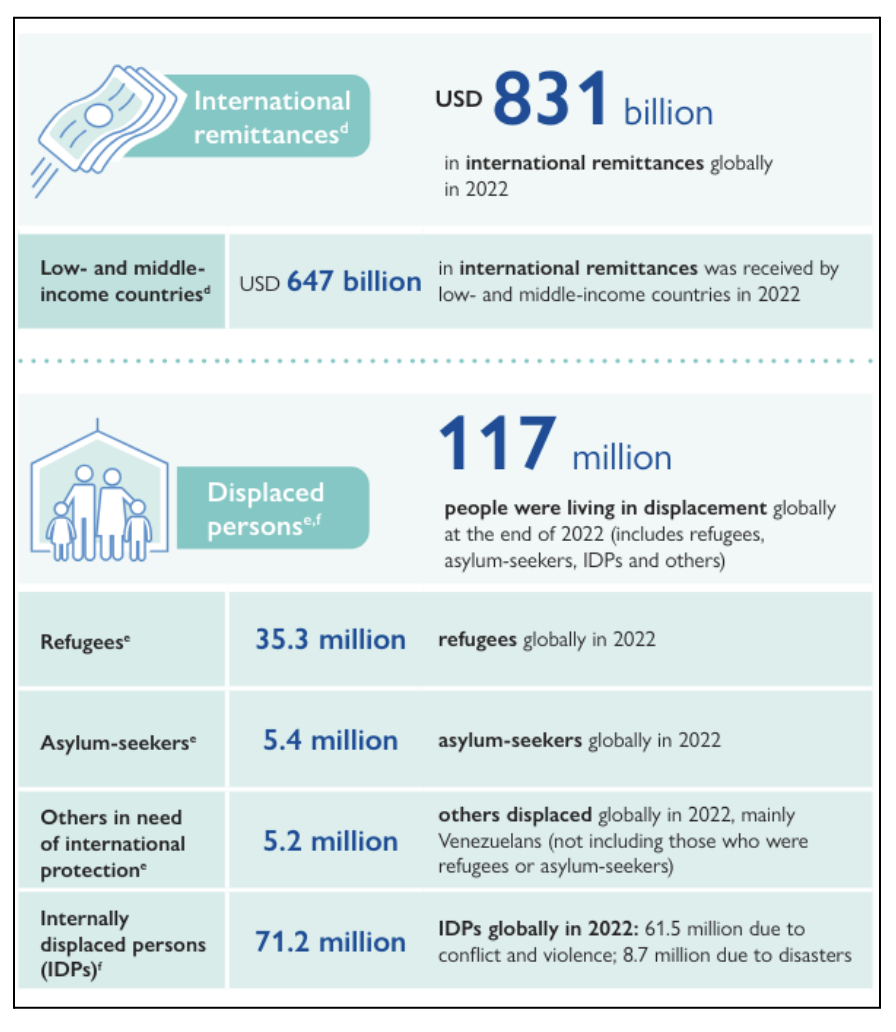
Chapter 3 focuses on key regional dimensions of, and developments in, migration. The discussion focuses on six world regions:
Africa:
- The latest available stock data (2020) show that around 21 million Africans were living in another African country.
- Irregular migration to, through, and from North Africa remains the defining feature of migration dynamics in the subregion, with many migrants suffering human rights abuses such as Xenophobia and racism.
- Conflict and violence continue to cause cross-border and internal displacement, while the subregion also hosts large numbers of refugees in protracted situations.
- International remittances remain significant to North Africa and are major sources of foreign exchange for several countries in the subregion.
Asia:
- It was the origin of over 40 percent of the world’s international migrants.
- In contrast to Africa, the largest internal displacements in Asia were the result of disasters, rather than conflict and violence.
- The demand for migrant workers in destination countries, unemployment and underemployment in countries of origin, and well-organized migrant smuggling networks have resulted in significant levels of irregular migration.
- The Middle East remains a major origin of refugees and asylum-seekers, while also featuring some of the largest internally displaced populations in the world.
Europe:
- The data shows that nearly 87 million international migrants lived in Europe, an increase of nearly 16 percent since 2015, when around 75 million international migrants resided in the region.
- In Europe, the distribution of female and male migrants is about equal across both the top 10 countries of destination and origin.
- The Russian Federation’s full-scale invasion of Ukraine in February 2022 resulted in one of the largest and fastest displacements in Europe since the Second World War.
Latin America & Caribbean:
- The data show that over 25 million migrants had made the journey north and were residing in Northern America.
- The total number of migrants from other regions living in Latin America and the Caribbean has remained relatively stable, at around 3 million.
- Intraregional migration in South America, including for labour, remains high.
- Latin America faces daunting challenges related to environmental degradation, disasters and climate change – including displacement.
- Violence – particularly gang-related violence – has resulted in a surge in displacement.
Northern America:
- The data show that nearly 59 million migrants were residing in Northern America from a variety of regions.
- As labour shortages take a toll on the economies of both Canada and the United States, both countries have devised or enacted strategies to attract migrant workers to fill critical labour gaps.
- Irregular migration to the United States remains an ongoing challenge and major policy issue.
- Canada continues to resettle more refugees than any other country globally.
Oceania:
- The data show that almost 8.3 million international migrants from outside Oceania were living in the region.
- Relative to their population, small island States, including those in Oceania, have the highest displacement risk due to climate change.
- Oceania, particularly Australia, remains a top destination for international students, whose numbers are recovering after a decline in 2020 and 2021 due to the COVID-19 pandemic.
Chapter 4: Growing Migration Inequality
- It examines the questions of “who migrates internationally, and where do they go?”
- It shows a growing “mobility inequality”, with most international migration now occurring between rich countries to the increasing exclusion of poorer countries.
- The analysis indicates that there has been a “polarizing” effect, with migration activity increasingly being associated with highly developed countries.
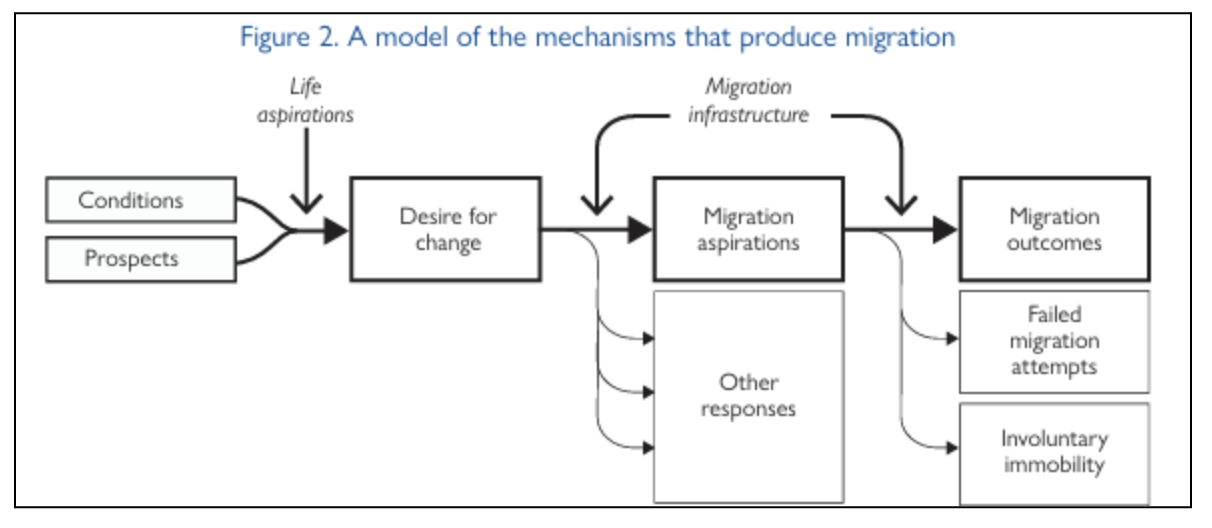
Chapter 5: Migration and Human Security
- The most significant link between migration and security relates to the human security of migrants themselves, rather than the national security of States.
- Migration and mobility can positively enhance people’s lives, and can save lives in the direst of situations. However, there do remain many situations in which migrants can be extremely vulnerable and have their security diminished or degraded during migration.
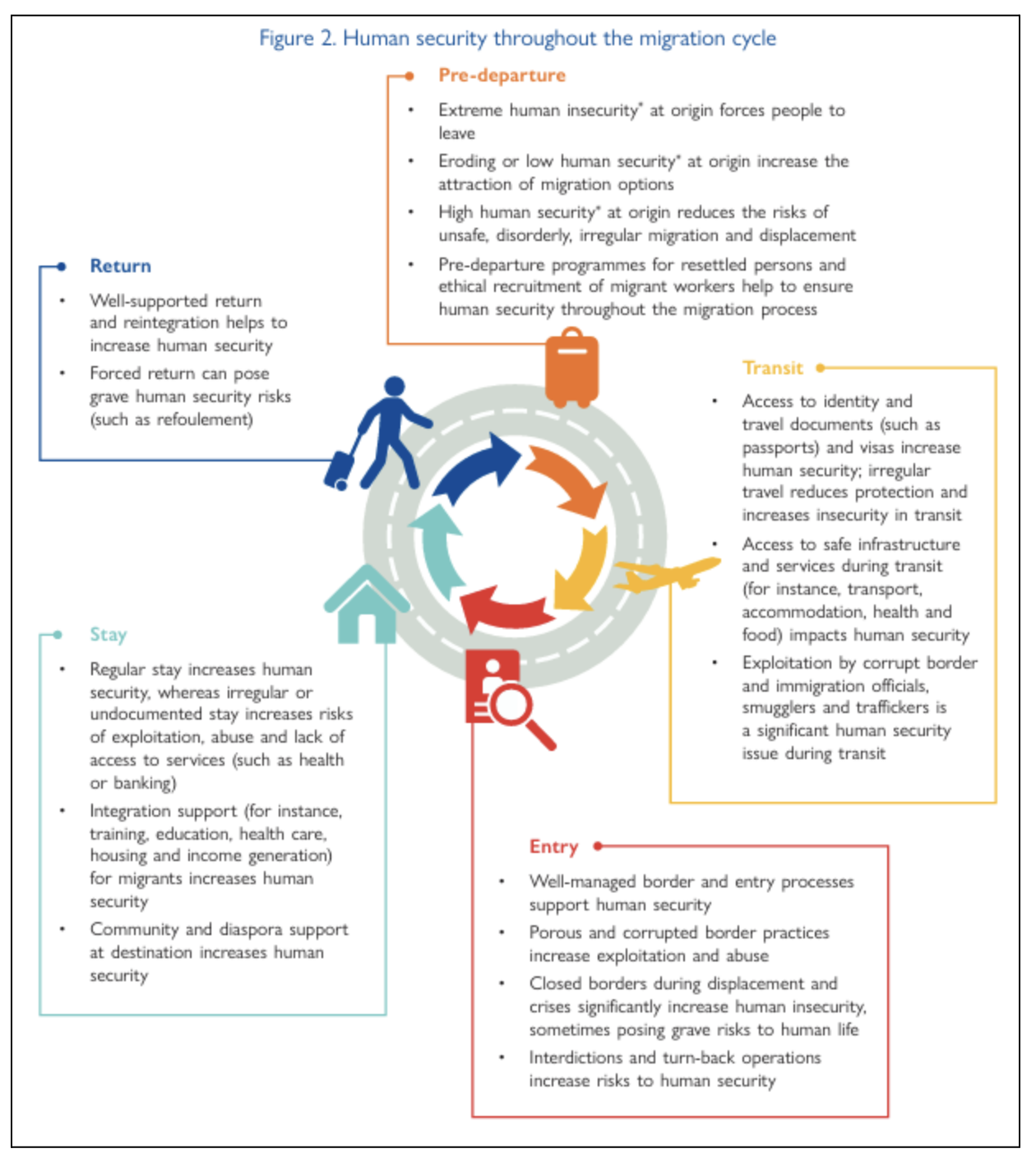
Chapter 6 – Gender and migration
- This chapter provides an overview of the interactions between migration and gender across diverse geographies worldwide.
- It covers family migration, marriage migration and displacement, with a particular focus on labour migration, one of the main – and highly gendered – types of migration.
- The chapter highlights the urgency of adopting a gender-responsive approach to migration governance to empower migrants of all genders and promote gender equality.
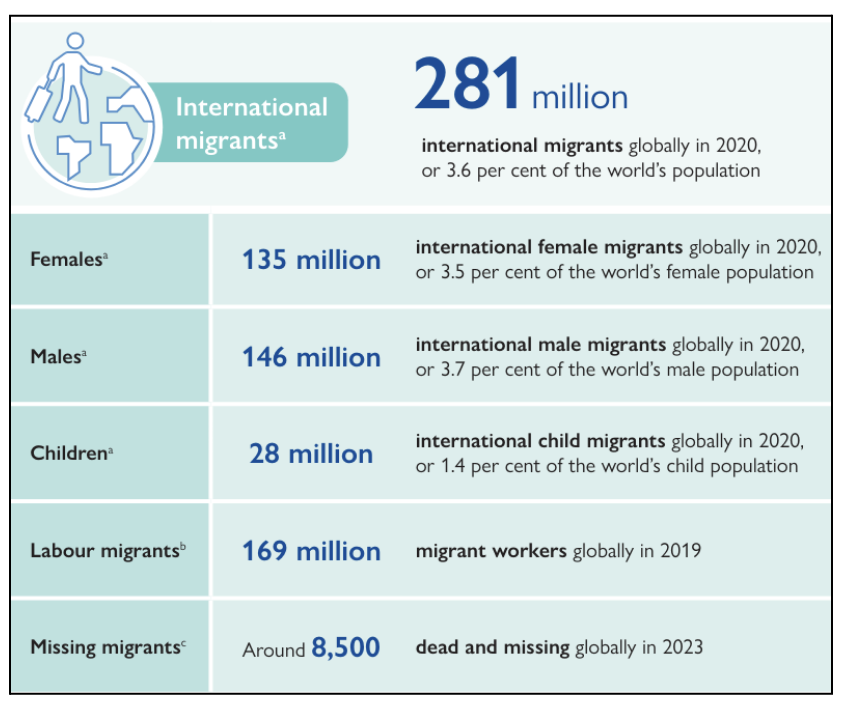
Chapter 7 – Climate change, food insecurity and human mobility:
- Evidence shows that climate change plays an important part in adding further pressure on existing systems and communities.
- Migration appears as a coping or adaptation strategy to reduce the adverse effects of climate change.
Chapter 8 – Towards a global governance of migration:
- It explores the impact of systemic crises and geopolitical changes, emphasizing the role played by the Global Forum on Migration and Development.
- Migration requires a truly whole-of-government and whole-of-society approach.
- Developments in global governance will only benefit all persons on the move if the emerging architecture accommodates this reality.
Chapter 9 – A post-pandemic rebound?
- This chapter examines the transformative effects of the COVID-19 pandemic on global migration and mobility.
- COVID-19 has catalyzed or accelerated social transformations, both temporary and structural, across regions.
- These transformations include changes in consumption patterns in developed and developing countries; high inflation and global economic slowdowns; demographic changes.


